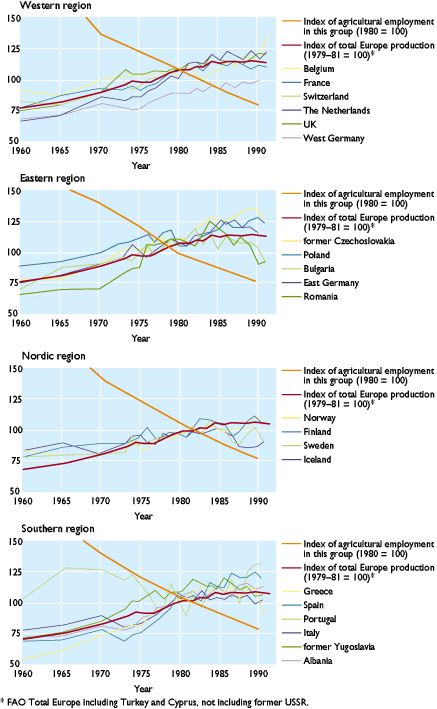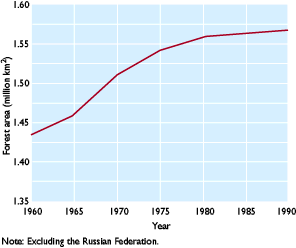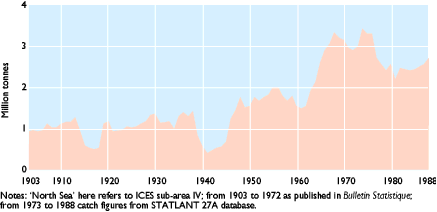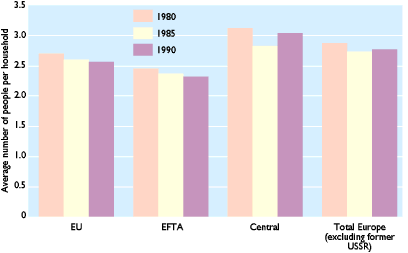19
Energy
Analyses energy-related activities at three stages
- production of primary energy, conversion to derived energy
(electricity and heat) and end-use - on local and pan-European scales.
Environmental impacts from fossil fuels, nuclear power and renewable
energy are briefly reviewed. Factors determining future energy use and
projected changes are presented.
- energy consumption and GDP have been decoupled
since the crises of the 1970s
- Europe uses 41% for industry, 22% for
transport and 37% for the domestic and commercial sectors
- Iittle improvement has been made recently in
energy efficiency in Western Europe
- energy use is responsible for air pollution,
acidification, tropospheric ozone, climate change and many other local
impacts on water, soil and land
20 Industry
Presents an overview of the environmental impact of
pan-European industry, and highlights differences between various parts
of Europe. The importance of industry as a whole in terms of emissions,
waste production and the use of natural resources is examined and an
evaluation is made of the 'environmental performance' of certain
industrial sectors. Ways in which business practice has changed in
response to environmental challenges are also considered. There is
little industrial data that can be directly related to environmental
impact. Production and energy use data are available from international
sources and national and state of the environment reports for specific
industries.
- energy consumption per unit output in the
chemical industry fell by 30% between 1980 and 1989
- chemical, pulp and paper, cement, steel and
nonferrous metal industries lead to the most severe environmental
impacts
- 25% of SO2 and 14% of nitrogen oxides were
emitted by industry in 1990 (20 countries)
- there is a trend towards reduction of all
emissions from industrial plants
 |
Electricity generation by source by country group
1990 |
| |
21 Transport
Reviews the impacts of transport on the environment
and provides an overview of the pan-European transport situation the
regional differences. Trends in transport activities and their
implications for the environment are examined, as well some underlying
forces. The future outlook for transport Europe is also assessed. The
main data used are drawn from international sources, especially the
European Conference of ministers for Transport (ECMT), Eurostat and
UNECE. Data from the scientific literature are used for
illustrating
- private car ownership doubled in Western
Europe between 1970 and 1990
- transport accounts for 25% of energy-related
CO2 emissions, with road transport making up 80% of the
total
- the total emission of pollutants will increase
in the next few years although emissions per vehicle will be
reduced
- Iand fragmentation due to the transport
infrastructure is increasingly impacting on landuse
- over the past 20 years in the EU alone, more
than one million people have died in road traffic accidents
22
Agriculture
Analyses the trends in agricultural structure and
practice which have evolved to meet demands and indicates the
associated potential impacts of agriculture on the environment.
Although plenty of data are available at national level, especially in
the ] and EFTA countries, most are related to production, employment
structure, fertilizer and pesticide use, livestock demographics and
farm sizes; fewer examine the size and contribution to impacts on the
environment of agricultural production and changes in agricultural
systems.
 |
Agricultural production and employees in
selected European countries |
| |
- agriculture accounts for 42% of Europe's total
land area. Farms tend to increase in size in Western Europe while the
importance of agriculture in the economy is declining
- there have been consistent gains in production
and labour productivity
- agriculture leads to water pollution, decline
of soil quality, loss of biodiversity and landscape changes, but it is
also a victim of environmental degradation
23 Forestry
Examines the situation of Europe's forests and how
they are being used. The chapter summarizes how associated activities
and practices can result in impacts on the environment, and identifies
the main driving forces influencing these changes The data used include
traditional forest inventories as well as qualitative information on
specific environmental effects and non-wood production forestry.
- forests cover 33% of Europe's land area, a 10%
increase over 30 years, most of it in the south and west while cover
has remained stable or declined in many eastern countries
- the introduction of non-indigenous species has
altered the composition of forests
- since 1965, European wood production has
increased by 18% and consumption by 28%

Evolution in wooded area in Europe
(Excluding the Russian Federation)
24 Fishing and aquaculture
Reviews the nature and importance of the impacts of
fishing on the environment, and provides an overview of the panEuropean
situation with regard to fishing and aquaculture, with regional
differences. The effectiveness of existing fishing policies are
evaluated. The main data sources are drawn from international
organizations (FAO and Eurostat) and examples are taken from state of
the environment reports and the scientific literature.

Total international fish catch in the North
Sea, 1903 - 1988
- fish stocks are overexploited in the northeast
Atlantic and the Mediterranean
- fixed and drift nets have an impact on marine
animals such as dolphins, monk seals and possibly porpoises and
seabirds
- effluent from aquaculture causes water
pollution
- the introduction of exotic species through
aquaculture may compete with or replace native species
25 Tourism and recreation
Presents an overview of the pan-European situation
with regard to tourism and recreation and highlights local differences.
The impacts of tourism and recreation are assessed in six key settings:
protected areas; rural zones; mountains; coastal areas; cities and
heritage sites; and theme and leisure parks. General trends are
presented using data from the World Tourism Organization, but since
tourism statistics do not adequately reflect the pressures of tourism
and recreation on the environment, a case-by-case approach using
national or local data is adopted.
- tourism is one of the most important social
and economic activities in the EU
- its impacts are exacerbated by the
concentration of tourist activity into short holiday seasons and
relatively small areas
- the environmental impacts from skiing are
considerable, especially in the Alps which receives 100 million
tourists per year
- the coastal Mediterranean received 157 million
tourists in 1990
- urban-based tourism is gaining
popularity
26 Households
Reviews the environmental impacts of households in
terms o resource use and emissions, assesses underlying driving force
and evaluates possible control measures. Data relating households
directly to the environment are not available. Socioeconomic data are
available from international organizations such as Eurostat. Case
studies using national data are used to help create a more complete
picture.
- consumption by households accounts for 70% of
industrial production in Europe
- an increase in the number of households
combined with a reduction in their size is leading to increased demand
for resources
- western European households now own on average
at least one car each, causing significant environmental
disruption
- the volume of waste from households continues
to increase, and although 50% of household waste could be recycled,
less than 10% is actually collected for recycling
- European households account for approximately
19% of total water supplied for all purposes, and this fraction is
increasing

European household sizes,
1980-90(Euromonitor)






Document Actions
Share with others